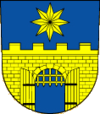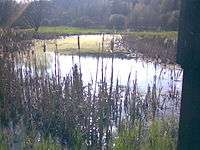Divišov
Divišov (German: Diwischow) is the market town in the Central Bohemian Region of the Czech Republic. It has about 1,800 inhabitants. It lies near the rivers Sázava and Blanice, 39 kilometres (24 mi) southeast of Prague.
Divišov | |
|---|---|
Tyrš Square | |
 Coat of arms | |
 Divišov Location in the Czech Republic | |
| Coordinates: 49°47′21″N 14°52′42″E | |
| Country | |
| Region | Central Bohemian |
| District | Benešov |
| First documented | 1130 |
| Area | |
| • Total | 30.98 km2 (11.96 sq mi) |
| Elevation | 511 m (1,677 ft) |
| Population (2020-01-01[1]) | |
| • Total | 1,758 |
| • Density | 57/km2 (150/sq mi) |
| Time zone | UTC+1 (CET) |
| • Summer (DST) | UTC+2 (CEST) |
| Postal code | 257 26 |
| Website | www |
Administrative parts
Villages Dalovy, Křešice u Divišova, Lbosín, Měchnov and Zdebuzeves are administrative parts of Divišov.
Development
The town was founded before 1130 but there had already been a monastery since the early 13th century. Legend says that in those times the fortress was a seat of the Templars who are said to have hidden a treasure somewhere in the Český Šternberk Castle. During the Hussite Wars, it was the centre of Catholic resistance to the violent Hussites: the major thief of Hussites Prokop the Great unsuccessfully besieged it three times, and it joined the league of Romanist nobles against King George of Poděbrady. In the 14th century, it was the tenth-largest town in Bohemia. In 1637 the town was occupied for eight months by the Swedes. In 1741, the Prussians vainly attempted to conquer the town. In the 18th century, development of industry and trade began to take place, which continued into the next century. Soon after the industrial revolution, the town became one of the industrial centres of Bohemia – sometimes it even being called the Czech Manchester. The electric power transmission has been installed at Divišov in 1924, gas 60 years later. During the 1920s and 1930s the town grew rapidly and due to many buildings of modern architecture Divišov became known as the Salon of the Bohemia. The first Nazi soldiers has been firmly welcomed on March 25, 1939. All 17 Divišov Jewish families had run away or have been ordered to transport out of Protectorate Bohemia and Moravia. No one of them got back home. At this time there lived also 2 Ukrainians. According to Nazi reglement each farmer had to transfer 80 kg beef and 25 kg pork for 1 hectare (2.5 acres) arable soil.
The development continued in the 20th century when the construction of D1 motorway linking Prague to Wien has been completed, the factory for the production of feber instruments, and the shop of armed vehicles were founded here.
Economy
Divišov is an industrial centre: there is JAWA, a motorbike factory, McNulty fortepianos, a transport company, a heavy machinery factory and an electronic equipment plant. Divišov also became well-known as a fish pond farming area.
Culture and sport
Since 1905, a famous horse race, Divišov Steeplechase has taken place every fall (third Sunday in October). It is said to be one of the quickiest horse races on the continent. Since 2006, the market town of Divišov has organized annual Rockfest Festival taking place in June, which has already become a local tradition, and has been attended by many Americans and Germans.
Jewish legacy
Divišov has an antique centre square and old Jewish town, old Jewish Cemetery 1706 and Jewish Museum with recently renovated Catholic Church from 1374 and old synagoge from 1779 that stay open until late in the evening. There is a growing Jewish community in the area.
Rabbis and synagogue ministry:
- 1852–1860 – Lazar Freund
- 1893–1905 – Jindřich Schwarzkopf
- 1906–1912 – Rudolf Glaser z Ledče
- 1913–1917 – Mojžíš Reither
Nature
As a central region, the Divišov region has had a complicated history. In the 20th century during WW2 it was part of the Nazi prohibited area, and large areas were stripped of population settlement.

Even before that human settlement was a little bit sparse and for centuries forests dominated over human dwellings and pathways. These former circumstances led to the unique preservation of unspoilt nature and forest ecosystems relatively unaffected by human activity. On the other hand, many habitats dependent on farming activity are slowly turning into forest. Notable and rare animals include the common kestrel and the black stork. Quite common are red deer and wild boars. Important Divisov endemic plants in the area are the Carpathian harebell (Campanula carpatica), Pulsatilla slavica, Hesperis silvestris, Liguria sibirica, and Saxifraga paniculata.
The Divišov region of deep forests is a popular holiday destination because it is excellent hiking country. Most interesting natural and cultural sights are connected with more than 500 kilometres (310 mi) of summer marked trails and many bike trails.
Transport
The town itself can be reached from other locations by inter-city buses via Highway D1 (Czech Republic) and by train Český Šternberk from Prague, Brno or Wien.
Leisure activities
For its sporting and leisure, visitors of Divišov can enjoy a group of ponds, some ponds are for fishing, the Želivka – despite official ban – is a natural swimming pool where yachting and windsurfing are possible.
The market town is a centre of tourism. The well-known Divišov-Sázava Cycle Route is part of an international network of cycling routes all over Europe. Gliding, paragliding and hang gliding are also popular sports in the Divišov Region.
Climate statistics
The market town is located on the edge of a mountainous region Bohemian-Moravian Highlands, which influences the local climate. Large parts of the area are covered with forests. The town is sought after for its natural environment and forests in summer as well as winter. The city dominant is the three mountains, which at 533 metres (1,749 ft) ASL, has views over a large part of Bohemia, all the way to Krkonoše and Blaník.
- Average annual temperature: +9.3 °C/+48.74 °F
- Absolute maximum temperature: +38.1 °C/100.58 °F (1964 and 1972)
- Absolute minimum temperature: -28.4 °C/-18.4 °F (1920)
- Average summer temperatures (June–August): +18.0 °C/+64.4 °F
- Average winter temperatures (December–February): -1.0 °C/30.2 °F
- Average annual precipitation: 53.8 centimetres (21.2 in)
- Average annual sunlight duration: 1820 Hours
- Average number of precipitation days/year: 150
- Warmest month: July
- Coldest month: January
- Typical wind: Northwest
Water transportation
The Divišov Region is near the dividing range between the watersheds of the Black Sea and the North Sea, where water collected by the Sázava and Blanice rivers flows. These rivers all spring from the Bohemian-Moravian Highlands. Owing to heavy precipitation (mostly snow), the peat bogs and the Želivka water dam, the Divisov region is an important water reservoir for Central Europe. More important for their aesthetic value than for holding water are several lakes of glacial origin (e.g. peatery and marsh near Drahňovice).
Divišov connected to Želivka and Prague Industrial areas via the Želivka Canal. Nearly all of Divisov's drinking water is brought to the town via large water pipeline, built in the half 19th century. The pipeline stretch 80 kilometres (50 mi) and the Želivka sources are pristine and the water does not require treatment.
Religions
Divišov is the seat of the Roman Catholic Church, and its acting Priest is father Knez. The religions of the Divišov resident population is divided according to the 2001 census as follows:
| Roman Catholic | 29.2% |
| Orthodox | 11.8% |
| Protestant (mostly Lutheran) | 7% |
| Jewish | 3.5% |
| Buddhist | 2.5% |
| Other or none indicated | 6.3% |
| No religion/Red | 39.7% |
Divišov community also runs the Region Journal and hosts a Centre for Christianity and Interreligious Dialogue.
Trivia
In one chapter of the novel Sedmikráska from Jaroslav Durych the author describes how a young virgin meets up with a local police officer from Divišov, who is constantly drunk and who mistakes her for a Russian spy.
References
- "Population of Municipalities – 1 January 2020". Czech Statistical Office. 2020-04-30.
External links
| Wikimedia Commons has media related to Divišov. |
- Official website
- Divisov at the official website of the Czech Republic, Czech.cz
- Divisov Region
- Welcome Tourism